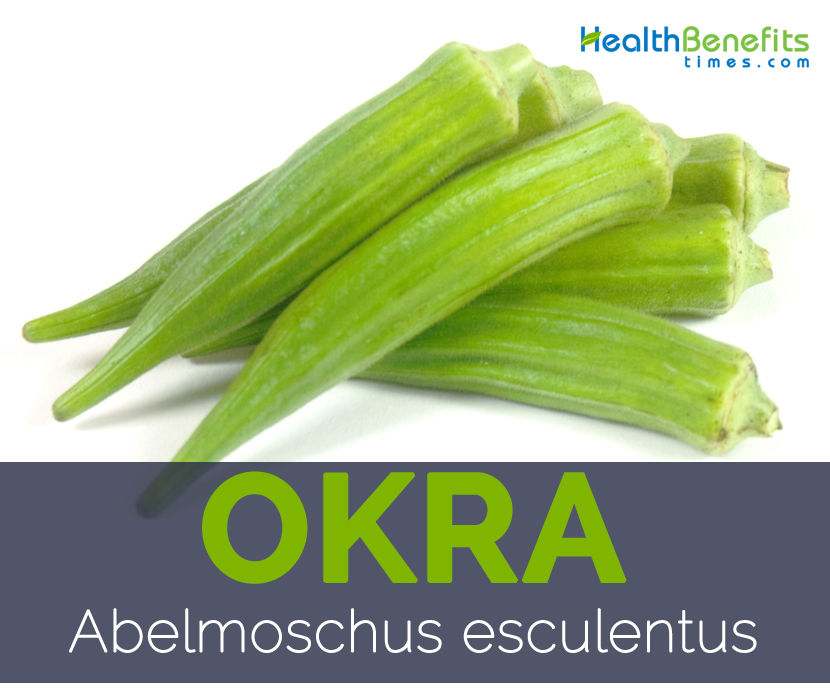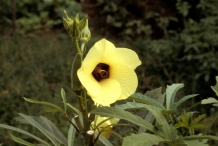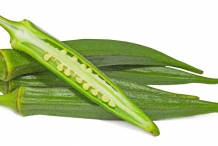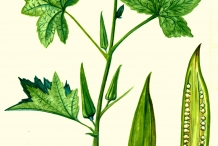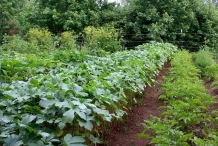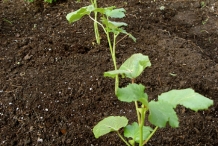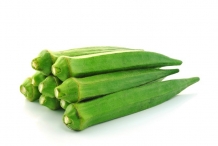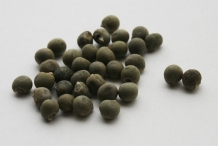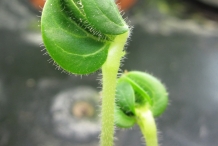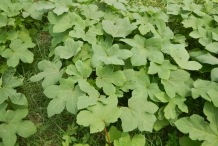Plant
Okra is an annual, tropical, erect herb sized 1-2 m tall and is native to Ethiopia. It is a tropical plant which grows best in warm environments. It is available year-round, with a peak season during the summer months. It thrives in warm tropical or subtropical climate and prefers well drained, rich light and heavy soils that include sandy loam, loam or clay soil. It is a short day plant that grows well in full sun and is rather cold tender. It is tolerant to drought and water-logging. It is quite popular throughout the world because of easy cultivation, dependable yield and adaptability to varying moisture conditions. Its stem is robust, erect, and variable in branching and varying from 0.5 to 2.0 m in height. Leaves are 10–20 cm long, alternate and broad, palmately lobed with 5–7 lobes. The okra flowers are 4-8 cm diameter, with five white to yellow petals, often with a red or purple spot at the base of each petal and flower lasts only one day.
Fruit
Okra is grown and eaten in many regions around the world and can add nutritional benefits to your diet, if used properly. Okra plant bears elongated, conical cylindrical capsule, 5–35 cm long, with longitudinal ribs down its length, hispid covered with fine hairs. Okra is normally yellowish green to green, but is sometimes purple or white. The pods are the edible portion, are harvested while still tender and immature. They grow rapidly into long (10-30 cm) and narrow (1-4 cm) pod with a tip that is either pointed like a beak or blunt. Its flavor is somewhat like a cross between asparagus and eggplant. Okra fruit contains numerous oval, smooth, striated, globular-reniform, 3–6 mm diameter, dark brown or dark grey, tuberculate seeds. It takes about 45-60 days to get ready-to-harvest fruits. The pods are handpicked while just short of reaching maturity and eaten as a vegetable. The pods, when cut, exude a mucilaginous juice that is used to thicken stews.
History
Okra supposedly originated in Ethiopia, the mountainous or plateau portion of Eritrea, and the eastern, higher part of Sudan. Okra has been found growing wild in Ethiopia and along the Nile signifying that it truly originated in this area. From this area it was carried Arabia and India. It was probably brought to the United States by French colonists to Louisiana in early 1700. Thomas Jefferson indicated in was being grown in Virginia before 1781. By 1806 several varieties of Okra were being grown. Okra is now much cultivated throughout the tropical and subtropical regions mainly for culinary purposes. Today okra is popular in Africa, the Middle East, Greece, Turkey, India, the Caribbean, South America and the Southern U.S. It is not a very common vegetable in most European countries, except for Greece and parts of Turkey.
Nutritional Value
In terms of nutritive value, Okra is a great source of vitamins and minerals, including Calcium, Iron, Magnesium, Phosphorus, Potassium, Sodium and Zinc, as well as vitamins A, B1, B2, B3, B5, B6, B9 and C. These are the main causes behind all of the health benefits that come from Okra. Apart from that several amino acids like Tryptophan, Threonine, Isoleucine, Leucine, and Lysine are also found in Okra which is extremely beneficial for our health.
Health benefits of Okra
As stated, Okra is abundant with several vitamins, minerals, and nutrients that handles the health advantages the plant provides. Here are a few of okra’s health advantages:
1. May Help Lower Cholesterol
Okra has been discovered to lower cholesterol levels in diabetic lab mice. Foods that have high fiber content and antioxidant qualities are suitable for those with diabetes because they lower cholesterol. The American Heart Association points out that people with diabetes are more likely to have unhealthy cholesterol levels. When high cholesterol levels are combined with diabetes, the outlook is not good. That’s why it’s so dangerous to make sure that your diet has healthy cholesterol levels.(1), (2)
2. Digestive Health
Perhaps the best part of adding okra to your diet is the significant increase it can have on your total fiber intake. Mucilaginous fiber like you find in okra can help move food through your digestive tract by adding bulk. This means that bowel movements are more regular and there is a reduction in gastrointestinal problems like cramping, bloating, constipation, and excess gas. Apart from that it also helps prevent diarrhea, because it adds bulk to watery stools. Lastly, fiber can help to clear out excess cholesterol in the body.(3)
3. Anti-Fatigue Benefit
Research has shown that recovery times and “fatigue levels” can be enhanced by use of the okra plant. Including okra in your diet along with a proper healthy exercise routine, you may be able to work out for longer and recover more quickly from your exercise. Cardiovascular activity is an essential part of preventing and treating diabetes. This means that the okra plant may contribute to a more active lifestyle.(4)
4. Vision Booster
Okra consists of considerable amount of vitamin A, as well as other antioxidant components like beta carotenes, xanthein, and lutein. Antioxidants are powerful compounds that may destroy as well as neutralize free radicals, which are the hazardous byproducts of cellular metabolism. Free radicals are actually responsible for the degradation of the cells in the body, including those responsible for vision. Sufficient amount of okra in your diet is extremely beneficial for eye sight, including macular degeneration and cataracts.(5)
5. Blood Pressure and Heart Health
Okra is a wonderful source of both vitamins and minerals, including potassium that is an essential aspect of human health. Potassium is essential to maintain proper fluid balance within the body, because it balances sodium. Additionally, potassium helps to relax the blood vessels and arteries, which consequently reduces blood pressure and reduces the strain on the cardiovascular system. This means that clotting and atherosclerosis will be greatly reduced.(6)
6. Anti-Stress Effects
Seed extracts of okra have an antioxidant, anti-stress effect in the bloodstream of mice. Managing stress levels is an important part of managing diabetes. Long-term, high stress levels can cause blood sugar levels to spike. Mental health should be a part of any diabetes treatment plan, and using okra and its derivative seeds can be a part of that plan.(7)
7. Skin Health
Vitamin A present in okra help to protect skin health, by promoting quicker healing, decreasing the appearance of scars and acne, and eliminating wrinkles. This is because the antioxidants are able to neutralize the free radicals which may have damaged those skin cells.(8)
8. Manage Diabetes
Soluble fiber can help diabetics because of its ability to keep blood glucose levels stable — it affects how sugar is absorbed in the intestines. In a research published in the journal ISRN Pharmaceutics, researchers soaked sliced okra pods in water and then gave rats the solution through a gastric feeding tube — a control group was not fed this solution. Research found that okra helped reduce the absorption rate of glucose and in turn reduced blood sugar levels in the treated rats.(9)
9. Immune System
Various antioxidant components present in okra make it very beneficial to fight off free radicals; however the high vitamin C content also means that the general immune system is boosted. Vitamin C helps to stimulate the immune system to create more white blood cells, which can combat the other foreign pathogens and materials in the body that can compromise the immune system.
https://www.youtube.com/watch?v=3jujs7uX_3g
How to Eat
- Immature fruits, flower buds, flowers and calyces, leaves and young shoots are used as vegetable (greens) and are eaten in numerous methods.
- Pods are eaten cooked on their own or eaten in soups and curries or sliced and fried with various meat.
- Fresh young pods can also be lightly sautéed in olive oil and eaten.
- Okra is also dipped in batter, deep fried and eaten.
- Okra is great when pickled.
- Okra can also be dried and powdered to use as a thickener.
- Pods are dried, sliced into sections, and then fried for a crunchy, almost bread-like snack in India.
- Pods, when cut, exude mucilage that is used to thicken soups, stews (gumbo) and sauces.
- Okra is the important ingredient in the dish canh chua in Vietnam.
- In Malaysia and Singapore, one popular Nyonya recipe consist of slicing cooked okra served with pounded dried shrimps and sambal belachan.
- Young fruits are added to sweet and sour curry.
- Immature fruits and young, tender shoots are eaten as lalab with rice in Indonesia.
- They are often used for sayor and tumis.
- Young fruits are eaten raw or cooked by steaming, boiling or blanching and served with chili sauces in Thailand.
- Okra is popularly served with soy sauce and katsuobushi or as tempura in Japan.
- Okra is cut into pieces and stir fried with red onions and spices, sautéed or added to gravy-based preparations like Bhindi Ghosh or sambar in south India.
- Okra is widely used in a thick stew made with vegetables and meat in the Middle East countries and Greece.
- Okra is also enjoyed in Nigeria where okra soup (Draw soup) is a special delicacy with Garri (eba) or akpu.
- Frango com quiabo is a Brazilian dish that is famous in the region of Minas Gerais.
- Okra is cooked and eaten in soup, often with fish in Caribbean islands.
- Okra is cooked with rice and maize; and also used as a sauce for meat in Haiti.
- It is an important ingredient in callaloo, a Caribbean dish and the national dish of Trinidad & Tobago.
- Breaded, deep fried okra is popularly served in the southern United States.
- Gumbo, a hearty stew whose key ingredient is okra, is found throughout the Gulf Coast of the United States and in the South Carolina low country.
- Young, tender leaves are also eaten raw in salads and used for flavoring.
- Leaves can be dried, crushed into a powder and stored for later use.
- Seeds are cooked or ground into a meal and used in making bread or made into ‘tofu’ or ‘tempeh’.
- Mature seeds are toasted, ground and used as a non-caffeinated substitute for coffee.
- Okra seeds provide good quality edible oil high in unsaturated fats such as oleic acid and linoleic acid and protein.
- The root is edible but very fibrous and mucilaginous, without very much flavor.
Other Traditional uses and benefits of Okra
- In Indian ethno medicine, an infusion of the fruit mucilage is used for treating dysentery and diarrhea in acute inflammation and irritation of the stomach, bowels, and kidneys catarrhal infections, ardour urinae, dysuria and gonorrhea.
- Mucilage can be used as a plasma replacement in India.
- A decoction of the immature fruit is considered demulcent, diuretic and emollient.
- Leaves and roots are demulcent, though less so than the fruit.
- When gathered in their green state and pounded, the pods make a valuable emollient poultice and so also the leaves.
- Seeds are reported to be antispasmodic, cordial and stimulant in India.
- An infusion of the roasted seeds has sudorific properties.
- An infusion of the roots is used in the treatment of syphilis.
- The juice of the roots is used externally in Nepal to treat cuts, wounds and boils.
- Decoction of young okra fruit is used to treat inflammation of a mucous membrane, especially of the respiratory tract, accompanied by excessive secretions.
- Okra juice is used to treat sore throat associated with coughing.
- Decoction of okra leaves, fruits and leaves are used to treat urinary problems, such as painful urination and other genitourinary problems including gonorrhea and syphilis.
- Okra leaves and roots used as poultice for wounds.
- Okra juice used to treat diarrhea with fever and associated abdominal pains.
- Okra juice used to treat skin itchiness and as skin moisturizer.
- Okra leaves used for inflammation.
- Okra fruits are eaten to treat involuntary discharge of semen.
- Roasted okra seeds are used to promote sweating.
- Okra seeds are used to treat and prevent muscle spasms.
- Decoction of okra is used to treat fever, headache and arthritis.
- Okra is rich in fiber that absorbs water and improves the bulk of stool. Effective against diarrhea and constipation.
- Okra’s mucilage binds with cholesterol and bile acids and expelled through stool from the body.
- Okra helps in lowering the blood sugar level by blocking the absorption of sugar in the intestinal tract.
- Okra’s mucilage acts as a lubricant and a laxative for the intestinal tract facilitating the easy passage of waste.
- Okra is believed to smoothen the skin and prevent the eruption of pimples and acne.
Other Facts
- Okra is occasionally cultivated as fiber plant; the fiber obtained from the stems is used as a substitute for jute.
- It is also used in making paper and textiles.
- Mature okra is used to make rope and paper!
Precautions
- The USDA notes that no copper, brass or iron cooking vessels should be used in preparing okra because the metal will be absorbed and the pods covered or even rendered poisonous. The cooking should be done in agate, porcelain or earthenware.
References:
https://en.wikipedia.org/wiki/Okra
http://www.foodreference.com/html/artokra.html
http://www.irjpas.com/File_Folder/IRJPAS%203(4)129-132.pdf
http://dbtbiosafety.nic.in/guidelines/okra.pdf
https://www.nicholsgardennursery.com/store/avactis-images/u/Okra.pdf
Comments
| Okra Quick Facts | |
|---|---|
| Name: | Okra |
| Scientific Name: | Abelmoschus esculentus |
| Origin | Ethiopia |
| Colors | Yellowish green to green, but is sometimes purple or white. |
| Shapes | Cylindrical capsule, 5–35 cm long, with longitudinal ribs down its length, hispid covered with fine hairs |
| Flesh colors | White |
| Calories | 35 Kcal./cup |
| Major nutrients | Vitamin K (53.33%) Vitamin C (29.00%) Vitamin B6 (23.00%) Manganese (20.43%) Vitamin B9 (18.50%) |
| Health benefits | Immune System, Manage Diabetes, Skin Health, Anti-Stress Effects, Blood Pressure and Heart Health, Vision Booster, Anti-Fatigue Benefit, Digestive Health, May Help Lower Cholesterol |
| More facts about Okra | |
| Rank | Scientific Name & (Common Name) |
|---|---|
| Kingdom | Plantae (Plants) |
| Subkingdom | Tracheobionta (Vascular plants) |
| Superdivision | Spermatophyta (Seed plants) |
| Division | Magnoliophyta (Flowering plants) |
| Class | Magnoliopsida (Dicotyledons) |
| Subclass | Dilleniidae |
| Order | Malvales |
| Family | Malvaceae (Mallow family) |
| Genus | Abelmoschus Medik. (Okra) |
| Species | Abelmoschus esculentus (L.) Moench(Okra) |
| Synonyms |
|


